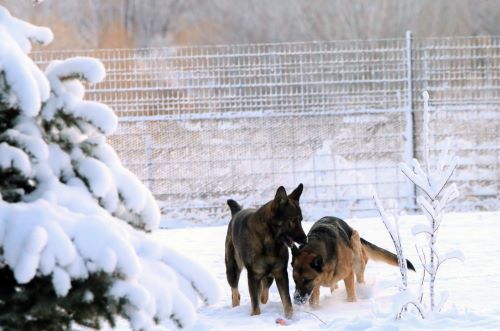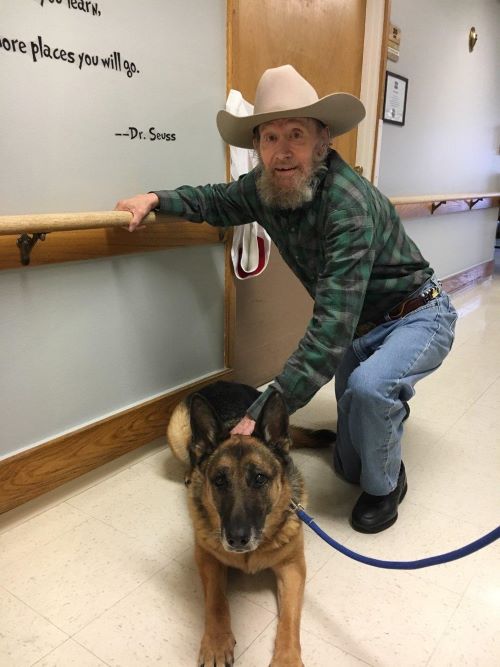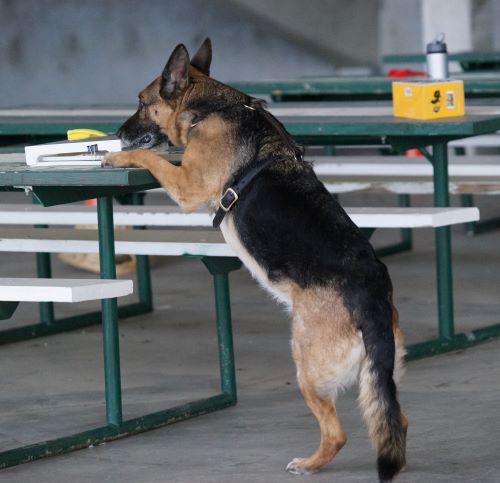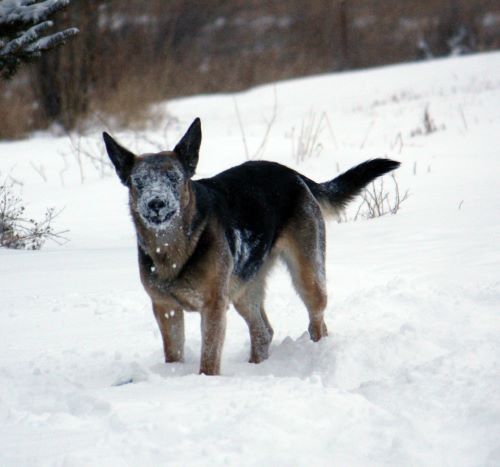Goodbye, Berakah
11/28/08 – 6/14/21
I had to put Berakah down on Monday, June 14th. Before Monday she was cheerful and determined to keep on celebrating life, but Monday she woke up barely able to walk and told me, finally, that she quit. It’s been a tough week. At least her special friends, Hesed and Hopeful, have finally quit looking for her. That definitely made me cry even more.
A year ago she came down with fibrotic myopathy, which is a weird German Shepherd condition where a muscle in their back leg for some unknown reason contracts and creates a knot of scar tissue. That causes them to be short-strided. Berakah had the bad luck to get it in both hind legs, and as it progressed it made her weaker and weaker in the rear.
In March she began having small strokes, and we think she had a brain tumor, as she would have times of confusion and an occasional zombie-like state. She continued getting a little weaker in the rear but insisted she could still chase her ball a few times each morning and would bark to get me up and moving so she could play.
But Monday morning she was really bad, as if she’d had another stroke. At every step one hock was wrapping around the other so she could barely watch. Each morning she and Hesed had the first ball session. First, I threw the ball as many times as Berakah wanted. As she began to fail – and slow way down – Hesed started racing after the ball and standing over it (holding her own ball in her mouth) until Berakah got to it, a real help for her in the tall grass.
When Berakah said she’d had enough ball, she traded for her Kong-on-a-Rope and then it was Hesed’s turn to have me throw – or kick – her ball as I wandered around doing poop detail. Berakah then chased Hesed. They had a ball doing this every morning. But Monday, Berakah finally just stood and watched as I did poop detail or kicked Hesed’s ball. And at one point she looked me in the eye and said it was too much. After she had a bad day the Tuesday before, Dr. Cindy agreed with my suspicion that she had a brain tumor and put her on 20 mg prednisone twice daily to hopefully help with any swelling that was causing her dizzy spells and zombie states. It did help and she perked up, but we never even made it through the 5 days before we could start lowering the pred dose. Berakah has always been a blessing to me (that’s what her name means in Hebrew), and so I gave her the last blessing of relief. Thanks to everyone who supported me on this journey.
Often, in situation like this, you wonder afterwards if she had really told you she was ready to go. Again, this time I have an amazing blessing that has comforted me: Hesed’s actions. Hesed really thought of Berakah as her mother. They were inseparable. About five years ago, Hesed tore her cruciate and had surgery to fix it. It healed perfectly but she thought it didn’t – she can be quite hard-headed about things. In this case, she still refused to go up the mudroom steps to come inside but races around the outside of the house so she can go up the deck steps and come in through the doggie door. Another thing she absolutely refuses to do is get on my bed. I have a two-step stool that all the other dogs use to get up on my bed, which is quite high, for our every-evening cuddle sessions. Not Hesed – if I invite her up she will crawl under the bed and stay there. But the last two weeks, as Berakah was seriously failing, she would use the stool and come up on the bed, stretch alongside me to talk and cuddle. Since Berakah died, she refuses to get on the bed and has resumed crawling under it. I can only think that she knew Berakah was not long for this world and was telling me and seeking comfort for her own grieving.
Berakah was a great Therapy Dog. She, with her dad, Chaos, pioneered our local Reading Dog program. We started at the Children’s Library, but they eventually cancelled the program because it was too hard for parents to get their children to the library for reading sessions in the afternoons. I created information packets for all the area schools about the benefits of children reading to dogs, and we were invited to do Reading Dog at Tongue River Elementary School in Ranchester, WY, about 20 miles from Sheridan. Chaos was gone by that time, but his two daughters – Berakah & GloryToo – started that program and, until covid hit, also did Reading Dog for a special reading class at Tongue River High School in Dayton, WY, about 25 miles from Sheridan. At that time we would go to the elementary school one Monday, and on alternate Mondays to the high school. When school started in September, 2020, the elementary school requested we come every Monday, which we did.
See Berakah’s therapy dog photos
When the kids told me they didn’t like the books the school provided, I asked them if they would read books about my therapy dogs. When they said yes, I began writing. Covid has seriously delayed the creation of the books, but in February, 2020, I took photos of the kids reading to Berakah, to use in the books.
See the kids reading to Berakah
In 2020, the Alliance of Therapy Dogs sent out an email about therapy dogs having their own trading cards that would be given out on visits. The one company doing it offered only one photo possibility per dog. That might be okay for groups who visit with multiple dogs, but it didn’t attract me at all. So I headed to Epiphany Printing, who are creating my books for Reading Dogs, showed them the ad and asked if we couldn’t create a set of cards for each of my dogs, so that I could give the kids a different card each week we did Reading Dog. Late this spring, we finished the first set – Berakah’s. I hope to have GloryToo’s and Lovely’s trading cards done before Reading Dog resumes in September 2021.
Berakah began training to be a therapy dog at a very young age. I take my litters to the nursing homes once they turn 5 weeks old. It’s part of my evaluation of each litter, and if I’m going to keep a pup, it had better enjoy those visits. Between car ride, the strange noises and smells that are part of nursing homes and being carried around and dumped into a bunch of laps, I get a good idea who is going to be imperturbable – and who will stress.
Berakah enjoyed the visits tremendously from the very beginning, and was definitely unflappable. One of my favorite memories is of a Reading Dog session at the Children’s Library. A woman had recently adopted two children from Europe and signed up the older one, a girl, to read to Berakah. She brought the younger one, a boy who was just at the running-around age. We did Reading Dog in the theater, which had a stage on one end and on the other a set of wide steps that rose gradually. I used a rug to create my therapy dog’s place and the children chose whether to sit on the rug with the dog or to the side, above or below. At this particular session, the girl settled beside Berakah and began reading to her, but the boy, totally oblivious to his mother’s admonitions to sit down and be quiet, began running up and down the steps, bouncing around and making a lot of noise. Berakah would glance at him occasionally, to keep track of where he was but spent most of her attention on the girl. The boy got wilder and wilder, and eventually hit the panic bar on the emergency door to the outside. The alarm began ringing, he began screaming, staff members began running into the theater, talking loudly as they tried to figure out who had the key to shut off the alarm. It was a zoo! It took them close to 10 minutes to turn off the alarm, and all that time Berakah lay by the girl as I encouraged her to continue reading and ignore the circus. Once quiet was reestablished, and the family left, the staff members raved about Berakah’s composure. That was my girl!!!!
See Berakah’s favorite photos, including visits to the nursing homes from 35 days of age
Berakah came down with pannus, an eye condition with a genetic connection, just as I was doing all her health screenings. Unable to breed her because of the pannus, I spayed her. Disappointing as it was, to have no chance to raise another pup like her, it did open possibilities that the other breeding females don’t have: Berakah never missed activities due to being in heat, pregnant or raising a litter. She was always available. And she was so eager to try anything new, I called upon her any time I needed a dog. As a tester/observer for Alliance of Therapy Dogs, I always need a dog to help test that the prospective therapy dog is okay around other dogs, neither aggressive nor overanxious to play. I always used Berakah. She handled the often-undisciplined dogs with aplomb. People often don’t realize the differences between the different kinds of dogs. Herding dogs, such as German Shepherds, are proud dogs who have a definite bubble of personal space that they resent having other dogs invade uninvited. Sporting dogs, on the other hand, seem to have no personal space nor instinctively respect another dog’s personal space. They’ll rush at another dog, invade its space and be all over it wanting to play. Their owners usually let this happen, saying “He just wants to play” and being insulted when the “vicious” other dog growls a warning to have some respect and get out of its face. I constantly have to explain this to people who want to have a therapy dog, that the rules insist on dogs being kept at least 3’ away from other dogs at all times on therapy dog visits so that none feel threatened or harassed. One time I was testing a group of people, which consisted of all herding dogs except for one lab. As I explained the 3’ rule, all the herding people were nodding their heads in agreement, while the lab owner gave the standard “He just wants to play” counter. I had to laugh later, as we tested each team, because as we did the required walk-by of Berakah with each dog, she totally ignored all the other herding dogs, who also ignored her. When it came time for the lab, it did the usual idiot sporting-dog “let’s play” bound toward Berakah, and of course its owner was unprepared to keep it with her and it came within the 3’ boundary. Berakah turned her head, gave it a dirty look and one admonitory “woof,” and kept heeling at my side. The entire group of people dissolved into laughter. Even the lab’s owner laughed, finally realizing the truth of what I had explained.
From the time she was certified as a therapy dog at 16 months of age (4/20/2010), Berakah visited the two local nursing homes regularly, where she was quite popular. Her sparkling personality attracted both staff members and residents. I created posters for each of my therapy dogs and the nursing homes would post them the morning of the day we were going to visit, so that everyone was looking for us. Unfortunately, due to the privacy protection laws, I have few photos of her with the nursing home residents whom she cheered for so many years.
Between those visits and Reading Dog, she was able to earn her Therapy Dog Excellent title from the American Kennel Club. That title required 200 therapy dog visits. Considering that I usually have six therapy dogs at any one time, and they all take turns at the nursing home visits, plus covid shutting down all visits for most of 2020 and half of 2021, I am quite proud of Berakah for earning that title.
Berakah had great fun doing a program at the Sheridan County Museum on the difference between therapy dogs and service dogs. While Laurie and her service dog, had to stay aloof from the kids, Berakah, as a therapy dog, got to schmooze with the kids to her heart’s content.
Berakah LOVED nosework, loved searching. She would bounce around and sing loudly as she waited for me to let her loose to search. At the trials, people would stop what they were doing to watch her when it was her turn to compete. In her honor, I will offer Berakah’s Award at every Sheridan nosework trial. The judge will choose the dog she (or he) likes best who searched well, had a good indication and had fun searching. I will pay the entry fees for that dog the next time it enters a Sheridan nosework trial.
As one of our nosework training group commented, “Berakah was our rockstar nosework girl. She made us all learn to love nosework. It made me teary and so proud of her legacy for others to shine and enjoy it as much as she did. Berakah is etched in our hearts forever. I will think of her every trial and training we do. Thank God for those memories. She will live on in this award, now.”
See Berakah’s nosework photos
Receiving an award for the most professional indication:
In a business advertisement
At a nosework trial
competing in vehicle searches
competing in interior searches
competing in exterior searches
She also loved agility in her younger years, before a cruciate injury made me retire her. No, she didn’t hurt it doing agility – she slipped on dew-laden grass here at home as she played with the other dogs one early summer morning. We didn’t have to do surgery, but I retired her from agility to be sure she stayed sound. That’s when we began nosework.
See Berakah’s agility competition and training photos
By now you should have gotten the idea that Berakah LOVED anything and everything. She made a lot of noise. She was so eager to begin each day that she acted as my alarm clock, the only problem being I could never set her to go off later. No matter what time we had gone to bed – how late or how busy we had been the previous day, or whether the new day was supposed to be a day off to rest – Berakah began barking when she tough it was time to get up, and she never quit until I was on my feet and moving to the kitchen to give her breakfast. It was the same at lunchtime or suppertime: at 1 p.m. and 6:30 p.m., she started either calling from her crate or barking at my side. I usually feed the dogs their lunch when we finish ball sessions. Generally, that is 1 p.m., but if we were running late, no way was Berakah going to wait. I would have to stop, feed those who had already had their ball time and cooled off (which, naturally, included her since she had the first ball time each day), then go back to ball sessions. If I had a class or a meeting that got me home later than 6:30, and I mean even one minute late, I was greeted by the most mournful cries that she was absolutely starving to death.
She sang when we got off the Interstate and she knew we were heading to the elementary school to do Reading Dog. She sang when we pulled into the nursing homes. She sang when we turned into the training arena’s drive. She sang when we stopped at any of the places where our training group meets to do nosework. She sang when she waited for her turn to compete in nosework or agility. And she complained if I was slow getting her treat to her when she made a nosework find. She neither suffered nor celebrated in silence.
Berakah was participating in two genetic studies on problems affecting German Shepherds. One is a continuing study on Degenerative Myelopathy. An earlier study found it was caused by a simple recessive gene, but some dogs have come down with DM who did not have both recessive genes for DM. The new study is looking for perhaps a modifier gene that didn’t show up on the original research, and the researchers put out a plea for dogs to participate in the study – one group being dogs that have been diagnosed with DM, and a control group of healthy dogs 7 years and older who do not have DM. I sent blood samples of all three of my dogs who are older than 7 – Berakah, lively and GloryToo – to be part of the control group. I include below the info from the project head. If anyone is interested in having their GSD participate in the study, email me and I will send you the form and vet instructions for taking the blood sample.
Hi Cel,
Our DM research project was just approved by AKC-CHF (American Kennel Club’s Canine Health Foundation).
I have arranged as part of the research, that there is no fee for dogs meeting the research criteria. The research criteria is: any GSD with DM, and any healthy GSD 7 years and older.
University of Missouri had agreed to allow us to submit samples before we received our formal funding due to the nature of the disease. Some of the affected dogs did not have time to wait for our formal funding. So we were allowing people to collect their dogs prior to euthanasia (heartbreaking contribution). Thank you so much for your willingness to participate in this important research project. Please do not hesitate to let me know if you have any other questions.
Respectfully,
Carolyn Z. Gerganoff
Health and Genetics Chair
German Shepherd Dog Club of America
Cell 760-443-3950
czgerganoff@hotmail.com
The other study is one that I’ve been actively involved with – trying to find a cause – and prevention! – for fibrotic myopathy. Several years ago, the researcher at the University of Wisconsin Vet School was contacting GSD breeders for help getting people to vote for them in a contest to win a big research grant. Berakah’s grandmother had developed fibrotic myopathy, which at the time was thought to only affect male GSDs, and for which they recommended surgery. I had taken her to CSU for the special surgery, which didn’t help – and shortly after that a new study came out with the finding that surgery was not worth it. It didn’t save Ashi from having to go through the surgery and 8-week recuperation process, so I was immediately interested in this potential study. They were the only canine study vying for the grant, so I mobilized all of my dog friends to vote – and the fibrotic myopathy project won the $10,000 grant! (https://jumpstart.supportuw.org/campaigns/discovery-of-the-genetic-basis-of-fibrotic-myopathy-in-the-german-shepherd-dog?fbclid=IwAR3yrp7cAeif0OxA8fyBVe3Op1r7raKsjrNSQ3kuqSvpGCmmbKbFoq4g94k#/)
In the process I became friends with the lead scientist, Dr. Emily. My dogs’ photos are featured in their information packet, and I donate monthly to the research. (You can follow the research on their Facebook page, where they share all the newest findings and publications from all studies including the fibrotic myopathy work: https://www.facebook.com/SVMgenetics)
When Berakah developed fibrotic myopathy in the summer of 2020, I contacted Dr. Emily and we put Berakah in the study. Since then, Dr. Emily has checked every so often to see how Berakah was doing and to let me know how the research is going, so when Berakah died, I sent her an email. She immediately called me to commiserate and commented that she considered Berakah an amazing dog, sure wished she had been able to meet her in person, and wanted me to know that Berakah had been one of the few dogs chosen to have detailed DNA analysis done as part of their research. What an honor. She went on to comment, “Berakah was truly an amazing German Shepherd Dog and her life was dedicated to service. She did light up any room she entered and her presence was captivating. She has contributed to the fibrotic myopathy research in such an impactful and profound way. She will continue to live on for years to come through her contribution to this research and will help advance the future of veterinary medicine and help many dogs in the future.”
Below is an email I received from Dr. Emily in March, 2021, with exciting news:
We have been working really hard on our fibrotic myopathy project and have been making great progress. We were able to get DNA samples from a small number of cases and controls analyzed with the really high quality state-of-the-art long read sequencing, which costs ~$3,000 per dog! From this data we have been able to look for genetic variants that exist between cases and controls. From our preliminary analysis we have found one really interesting variant that looks like it is different between cases and controls! Which is so exciting!! We are working to investigate that region in the genome and have found a really interesting candidate gene that may be associated with causing disease. All of this work is preliminary though because the cost per sample is prohibitive to us analyzing all the samples we have collected at once. Going forward we are looking to generate long read sequencing for more cases and controls and see if this variant is still present in the dogs affected with fibrotic myopathy and absent in dogs not affected with fibrotic myopathy.
Then going forward, we will be able to create a PCR test that will easily screen a much larger number of dogs for a lot less money/ We are so excited about this project and your financial contributions are being used to directly fund the generation of data for this project.
Thank you so much for your continued dedication to supporting our research, it means so much to us and the future dogs this research will impact.
Warm regards,
Emily
(Dr. Emily Binversie DVM PhD MS
SVM Genetics <genetics@vetmed.wisc.edu> )
Berakah truly believed that life was to be celebrated, every moment of every day. Each new day was an adventure ready to unfold, and she bounced into it with enthusiasm. She blessed me with that attitude and I’m a better person for having known her. Years ago, I had come across the Hebrew word for blessing – “berakah” (pronounced ber-a-kah’ – emphasis on the last syllable) in a Scripture study and fallen in love with it. I saved it until a very special puppy came along, one whom I thought might embody the message that all of life is a blessing. She was aptly named. She was one of a kind, and I miss her and am so very grateful she blessed my life for 12 ½ years. Wait for me Berakah, and enjoy playing with your mother (Joyful), dad (Chaos), grandmother (Ashi), great-grandmother (Glory), and all the others whom I have loved – and been blessed by – over the years. I will see you again one day. And meanwhile, thanks for all the blessings.




